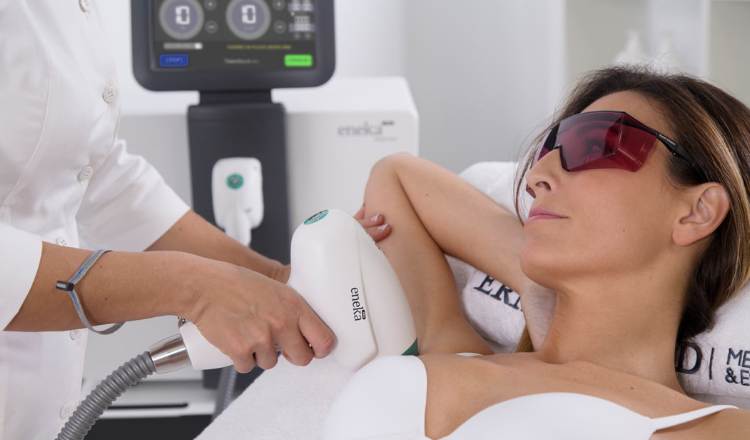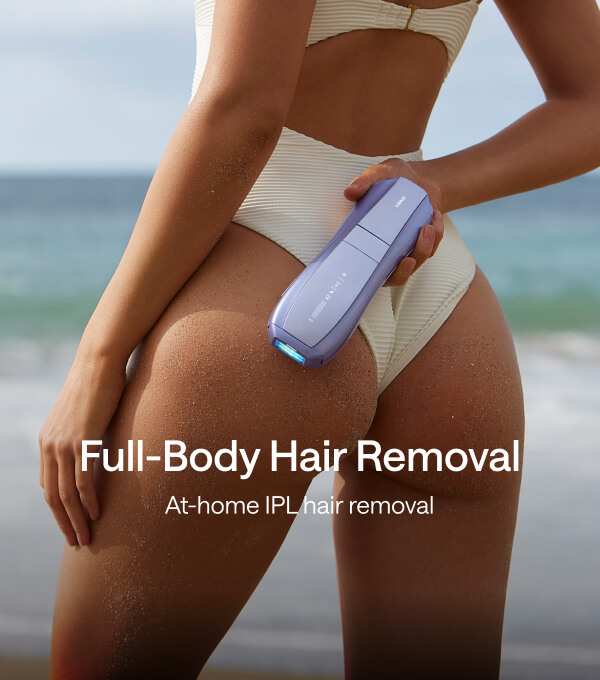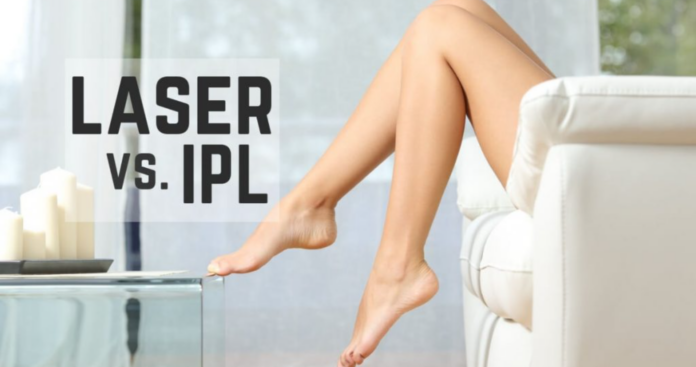Of all the concerns about at-home laser hair removal, the most appalling is the association with skin cancer. Thus, the point of today’s discussion was the link between at-home laser hair removal and skin cancer.
Then it is the right time to discuss “Can laser hair removal at home cause cancer?” and if you should go for it or not.
Table of Contents:
- Part 1: What is the Technology Behind Laser Hair Removal?
- Part 2: What Are the Myths Related to At-Home Laser Hair Removal?
- Part 3: Can Laser Hair Removal at Home Cause Cancer?
- Part 4: Is Laser Hair Removal Safe? If Yes, How?
- Part 5: What are the Side Effects of At-Home Laser Hair Removal?
- Part 6: How to Prevent Side Effects of Laser Hair Removal at Home?
Part 1: What is the Technology Behind Laser Hair Removal?
At home laser hair removal depends on radiation technology. Laser light is a form of radiation from 500 nm to 1200 nm. It is comprised of waves of different wavelengths combined to form a broad spectrum of light.
Then this light spectrum attacks the pigment of the hair. It travels all the way through the length of the pigment of the hair and gets to the hair follicles.
At the finding of hair follicles, noncoherant rays of broad spectrum rays are converted to heat energy destroying the hair follicle.
Furthermore, it is important to note the reasons why multiple lights are used as mentioned in ResearchGate Publication {1},
- The shorter the wavelength of light, the greater its dispersion and the lesser the absorption
- The longer the wavelength of light, the more the penetration and better the photothermolysis effects
Thus, polychromatic rays allow at-home lasers to target hair follicles at different levels of the skin without harming the skin.
Part 2: What Are the Myths Related to At-Home Laser Hair Removal?
Although there are a number of myths surrounding at-home laser hair removal we will only discuss what people say about laser hair removal and cancer. Here are some,
- Laser hair removal contains UV rays which damage the tissue and are known to damage the DNA.
- At home IPL devices eliminate moisture and needed nutrients from the skin cells, leading to cancer.
- Light of longer wavelengths can travel further and cause damage to the cells beyond the follicles
- People who have skin cancer cannot use this in case because it can cause a recurrence of cancer
- Moles on the body can become atypical (badly developed) or cancerous when the laser is used to convert a typical or benign mole to an atypical or cancerous one
Do you want to know how many of these myths are true? If so, let us discuss it, in the next section.
Part 3: Can Laser Hair Removal at Home Cause Cancer?
Over 2 decades of the utilization of lasers to get rid of unwanted hair, there has not been a single incident in which anyone has reported the development of skin cancer after laser hair removal treatment.
Additionally, here are the points in favor that at-home laser hair removal cannot cause cancer.
Nature of Laser Radiations
Cancer is caused due to destruction or mutation in the DNA strands. This mutation occurs because of the knocking off of the electrons by low-wavelength radiations as UV rays present in the sunlight. When it comes to at-home laser hair removal rays,
These are all non-ionising radiations as explained by the Cancer Council [2]. The spectrum of light starts from 500 nm which is infrared and beyond the UV spectrum.
Additionally, most IPL devices have UV filters to ensure that no harmful rays get past the treatment window.
The Extent of Penetration of At-Home Laser Hair
For at-home laser hair removal to cause cellular damage, the light needs to penetrate deeply. However, even the 1200 nm light rays of at-home laser hair removal devices can only go as deep as hair follicles.
Also, you can guess the level of penetration of at-home lasers by a figure posted in the Research gate [3]. Therefore, the extent of penetration of IPL rays is another point proving that they do not cause skin cancer.
The Effect of at-Home Laser Hair on the Skin
The light of at-home laser hair removal devices targets “pigment” which might be that of the hair or the skin. This is why high color contrast between your skin color and unwanted hair is required.
So, the broad spectrum of IPL rays means that some of the light might also be absorbed into the skin in addition to hair. The Effect of such rays is minimal on light skin tones and harmful on dark skin tones. However, many IPL devices have skin tone sensors to ensure that light does not flash on incompatible skin tones.
The Association of Laser with Skin Cell Dehydration
The energy output of at-home laser hair removal devices ranges from 4 J/cm2 to about 20 J/cm2. This energy output and heat caused by it are not sufficient to cause any cellular dehydration or malnutrition. So, at-home does not harm the skin cells [4].
Also, some IPL devices come with skin-soothing technologies like sapphire ice-cooling to neutralize the heat.
Use of Laser Hair Removal on Benign Moles
The laser hair removal treatment is not recommended for areas marked by moles. This alters their appearance and color; therefore, they can change from benign to malignant moles.
Always refer to a healthcare professional regarding the use of IPL in areas with moles, as indicated in the article from Valeo Health Clinic [5].
Use of Laser Hair Removal on People With a History of Cancer
While laser hair removal is safe in general, it should be avoided for those with a history of cancer. It is preferable to consult a dermatologist before treating oneself at home.
Part 4: Is Laser Hair Removal Safe? If Yes, How?
We hope you have the answers to all the myths regarding laser hair removal and cancer. Laser hair removal is regarded as, entirely safe. It is noteworthy that any laser device used for hair removal is only approved by the FDA and put on the market after it has adequately tested its safety and effectiveness on human skin.
Consequently, you may use home laser hair removal products with very minimal side effects as long as the home laser product is FDA-cleared.
Part 5: What are the Side Effects of At-Home Laser Hair Removal?
Laser hair removal does not cause cancer nor is it unsafe for the skin. However, here are some of its side effects.
A. Skin Redness
It’s natural to see some redness in the skin after laser hair removal; no need for you to worry. The extreme light of the laser itself leads to redness and irritation of the skin. Generally, the redness disappears after a span of a few minutes to a few hours.
If the skin irritation becomes unbearable, then cold compresses may be used.
B. Pain and Discomfort
You may feel something akin to prickling on your skin with at-home laser hair removal. Some might call it pain, and others discomfort merely.
Again, it only lasts for the time of hair removal or minutes after that and could be relieved by an IPL device, which uses ice-cooling technology.
C. Skin Blisters and Scarring
Using at-home laser devices on skin tones that are not compatible can lead to burns in the hyperpigmented area of the skin. Those burns can lead to the formation of skin blisters, which can then cause scarring.
Part 6: How to Prevent Side Effects of Laser Hair Removal at Home?
A. Follow Safety Precautions
Laser hair removal devices come with a specific set of instructions, precautions, and warnings. You have to read them and obey all the precautions to avoid the harmful effects that at-home laser hair removal can bring about. For example,
- Shave the hair prior to the treatment
- Use the device on skin with a healthy skin barrier
- Follow all pre and post-care tips for laser
B. Use FDA-Cleared Devices
Though at-home laser hair removal is FDA-clear, the device used needs to be FDA-clear too. Supplementary, FDA-cleared devices carry with them:
- UV filters
- Skin tone sensors
C. Use the Device only on Compatible Skin Tones
Last but not least, choosing a device meant for your hair color and skin tone to avoid irritation and side effects while using at-home laser hair removal devices is another way to save your skin.
You can check out the compatibility chart given on the websites of the brands of authentic IPL devices.
Conclusion
Home-use laser hair removal is an FDA-regulated and cleared process to assist individuals in reducing unwanted hair at home. The fact that the laser uses non-ionizing radiations in the spectrum beyond UV light indicates that such rays cannot be damaging to the DNA strands and will not cause cancer.
Additionally, IPL devices come equipped with added safety mechanisms to protect the skin.
References
- A Relationship Between Intse Pulse Light and Laser Wavelength and Depth. Alessandro Martella, Mauro Raichi. June 2017. Research Gate. https://www.researchgate.net/figure/A-Relationship-between-intense-pulsed-light-IPL-and-laser-wavelength-and-depth-of_fig1_317635047
- Ask the Expert: Can Laser Treatment for Sun Damaged Skin Cause Skin Cancer? Deborah S. Sarnoff, MD. Nov 12, 2020. Skin Cancer Foundation https://www.skincancer.org/blog/ask-the-expert-can-laser-treatment-for-sun-damaged-skin-cause-skin-cancer/
- Depth of penetration by various lasers. Liuza Pitassi. Nov 2013. https://www.researchgate.net/figure/Depth-of-penetration-by-various-lasers-This-figure-was-published-in-Dermatology_fig2_258502077
- Can laser hair removal cause cancer? Skin Perfection: The Skin and Laser Specialist. https://www.skinperfectionlondon.co.uk/2022/02/can-laser-hair-removal-cause-cancer/
- Understanding the Relationship Between Laser Hair Removal and Moles. Valeo Health Clinic. https://valeohealthclinic.com/blog/understanding-the-relationship-between-laser-hair-removal-and-moles/

 By Nancy H, PharmD
By Nancy H, PharmD








